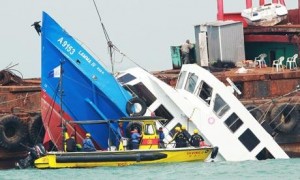TNO – Stress Fields Inside of a Neck for more Accurate Crash Analysis #SWI2013
Background
As a material (typically, a metal) is stretched, it can reach a point where all of the strain (deformation) is concentrated in just one area. For example, notice in the figure below how the material has become very narrow across a short length in the specimen which was initially cylindrical. This condition is called “necking.” A good summary can be found in Bower or Wikipedia (see references). Within the neck, the state of stress becomes fully 3- D and can no longer be represented by the state of stress in the surrounding material. Bai and Wierzbicki (2010) have shown that material failure depends on a fully 3-D situation, so knowledge of these 3-D stresses are relevant. However, failure models like that of Bai and Wierzbicki (2010) are often applied in 2-D scenarios by ignoring the 3-D state of stress inside of the neck, and only applying the far-field stress. The goal of this project will be to use insight into the 3-D state of stress inside of a neck to simplify Bai and Wierzbicki’s (2010) 3-D failure locus into a 2-D one that accounts for the state of stress inside of the neck better than the current ones, which only apply far-field stresses. This is anticipated to be more accurate than the current 2-D assumptions, but require approximately the same effort from the user.
The accurate and simple modeling of phenomena like necking is important for a number of applications. A key application is the simulation of collisions. As two bodies (e.g. ships) collide, the material is deformed all the way to failure, including the possibility of necking in components that are loaded primarily in tension. While it is not possible to model the collision of two ships with enough detail to capture necking, it would be possible if it were possible to make simplified models of necks in two dimensions. The picture below comes from a recent collision of two ships in Hong Kong in which dozens of lives were lost. While such collisions may be unavoidable, they may be made more survivable by more reliable simulations and understanding of the collision process.
Suggested approach
Bridgeman’s 1952 work provides a detailed description of how he created an analytical model for the state of stress in axisymmetrical bars and flat plates. However, it requires knowledge of the necking radius (a/R ratio in the figure below) to be known a priori. The first goal would be to make a model of the necking radius so that Bridgeman’s approach could be applied based only on far-field stresses and material data. This might be found in the literature, but it is more likely that an axisymmetrical solution would need to be modified for flat plates. The results of this analysis can be validated by FEA if necessary (within the Mathematics Study Group, or contributed in-kind). Once a plate solution is developed and validated, it can be extended to scenarios in which prescribed out-of-plane stress or strain is applied. In this way, it can be extended to fully 3-D. Finally, the 3-D neck solution can be substituted into the failure model, and the differences between the current 2-D assumption and the proposed one can be evaluated. This will be used to evaluate the consequences of the current unrealistic assumption.
Goal:
If this project succeeds, it will produce a correction in sheet or plate metal fracture criteria to account for the development of 3-D stresses as material necks. This has applications in the simulation of crash and stamping operations.
References:
Bai, Y, and Wierzbicki, T (2010) “Application of extended Mohr-Coulomb criterion to ductile fracture.” Int. J. Fract, 161:1-20.
Bridgeman, PW (1952) “The Effect of Nonuniformities of Stress at the Neck of a Tension Specimen” In: Studies in large plastic flow and fracture. McGraw-Hill Book Company, Inc., New York. pp 9-32.
Bower, AF “Chapter 9.2.6: Ductile failure by strain localization” In: Applied Mechanics of Solids. http://solidmechanics.org/text/Chapter9_2/Chapter9_2.htm


